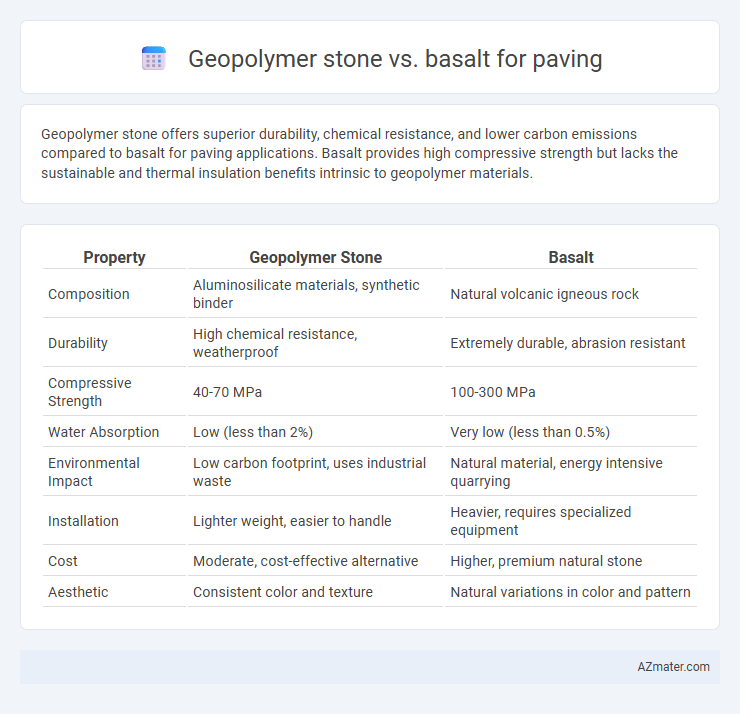Geopolymer stone offers superior durability, chemical resistance, and lower carbon emissions compared to basalt for paving applications. Basalt provides high compressive strength but lacks the sustainable and thermal insulation benefits intrinsic to geopolymer materials.
Table of Comparison
| Property | Geopolymer Stone | Basalt |
|---|---|---|
| Composition | Aluminosilicate materials, synthetic binder | Natural volcanic igneous rock |
| Durability | High chemical resistance, weatherproof | Extremely durable, abrasion resistant |
| Compressive Strength | 40-70 MPa | 100-300 MPa |
| Water Absorption | Low (less than 2%) | Very low (less than 0.5%) |
| Environmental Impact | Low carbon footprint, uses industrial waste | Natural material, energy intensive quarrying |
| Installation | Lighter weight, easier to handle | Heavier, requires specialized equipment |
| Cost | Moderate, cost-effective alternative | Higher, premium natural stone |
| Aesthetic | Consistent color and texture | Natural variations in color and pattern |
Introduction to Geopolymer Stone and Basalt
Geopolymer stone is an innovative, eco-friendly material made from industrial by-products like fly ash and slag, offering high compressive strength and chemical resistance ideal for paving applications. Basalt, a natural volcanic rock known for its durability, density, and weather resistance, has been extensively used in paving due to its superior load-bearing capacity and wear resistance. Comparing the two, geopolymer stone provides sustainable benefits and customizable aesthetics, while basalt delivers proven natural strength and longevity in outdoor environments.
Composition and Formation Processes
Geopolymer stone consists of aluminosilicate materials activated by alkaline solutions, creating a synthetic stone through polymerization of industrial by-products like fly ash or slag. Basalt is a natural igneous rock formed from the rapid cooling of basaltic lava, rich in minerals such as pyroxene and plagioclase feldspar. The engineered composition of geopolymer stone allows customizable properties compared to basalt's inherent volcanic mineralogy and crystalline formation.
Strength and Durability Comparison
Geopolymer stone exhibits high compressive strength typically ranging from 50 to 90 MPa, rivaling or exceeding the strength of basalt, which averages around 100 MPa but varies with geological origin. Both materials offer exceptional durability, with geopolymer stone showing enhanced resistance to chemical corrosion and freeze-thaw cycles due to its synthetic composition, whereas basalt's natural mineral structure provides excellent wear resistance and longevity in harsh environmental conditions. In applications requiring sustainable alternatives, geopolymer stone's customizable formulation allows for tailored strength and durability properties, making it a competitive choice against traditional basalt for paving projects.
Environmental Impact and Sustainability
Geopolymer stone significantly reduces carbon emissions by utilizing industrial waste materials like fly ash and slag, offering a sustainable alternative to traditional basalt paving that requires high-energy mining and processing. Basalt, while durable and natural, involves extensive quarrying that disrupts ecosystems and generates substantial CO2 emissions, impacting long-term environmental health. The low embodied energy and recyclability of geopolymer stone make it a more environmentally responsible choice for paving applications aiming to minimize ecological footprint.
Installation Methods and Ease
Geopolymer stone offers a lightweight and modular installation process that requires less specialized equipment compared to basalt, making it easier and faster to lay in paving projects. Basalt, being denser and heavier, demands more labor-intensive methods, often involving heavy machinery and precise cutting techniques for proper fitting. The ease of installation with geopolymer stone reduces overall labor costs and project timelines, particularly in large-scale or complex paving applications.
Aesthetic Variations and Design Options
Geopolymer stone offers a wide range of aesthetic variations due to its customizable pigments and textures, allowing for precise control over color and pattern that can mimic natural stones or create unique artistic designs. Basalt provides a more uniform, natural appearance with deep, rich black and gray tones, favored for minimalist or contemporary paving projects. The versatility of geopolymer stone enables designers to experiment with intricate layouts and vibrant palettes, while basalt's consistent look suits traditional and modern architectural styles seeking durability and subtle elegance.
Cost Analysis and Long-Term Value
Geopolymer stone offers a cost-effective alternative to basalt for paving, with lower material and production expenses driving reduced upfront investment. Basalt, while more expensive initially due to quarrying and processing costs, provides superior durability and weather resistance, contributing to lower maintenance and replacement expenses over time. Evaluating long-term value, geopolymer stone delivers competitive lifecycle costs through ease of repair and sustainability benefits, whereas basalt's robustness ensures extended service life in high-traffic and harsh environmental conditions.
Maintenance Requirements
Geopolymer stone requires minimal maintenance due to its high resistance to chemicals, weathering, and abrasion, reducing cleaning frequency and repair costs. Basalt, while durable, often demands more frequent sealing and cleaning to prevent surface degradation and maintain appearance. The low porosity of geopolymer stone also limits water absorption, minimizing damage from freeze-thaw cycles compared to basalt paving.
Real-World Applications and Case Studies
Geopolymer stone offers superior sustainability and chemical resistance, making it ideal for urban paving projects exposed to industrial pollutants and heavy traffic. Basalt, renowned for its natural strength and durability, is widely used in historic preservation and high-traffic public spaces such as plazas and pedestrian zones. Case studies in cities like Rotterdam demonstrate geopolymer stone's rapid curing times and lower carbon footprint, while basalt's longevity is evident in ancient structures that have endured centuries without significant wear.
Choosing the Best Material for Your Paving Project
Geopolymer stone offers superior environmental benefits and durability compared to basalt, making it ideal for sustainable paving projects that require high compressive strength and resistance to chemicals. Basalt provides excellent natural aesthetics and thermal stability, often preferred for traditional paving with high traffic and weather exposure. Selecting the best material depends on project priorities such as eco-friendliness, mechanical performance, cost-effectiveness, and desired design outcomes.

Infographic: Geopolymer stone vs Basalt for Paving
 azmater.com
azmater.com